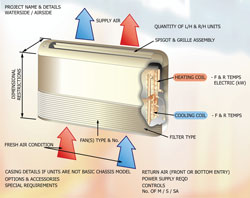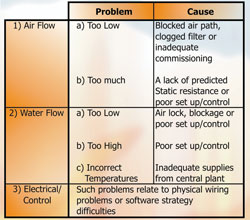IT IS clear from the information supplied in our last three articles that although the chilled water FCU is a relatively simple collection of components, should the selection, application and build/supply process be flawed in any way, then the consequential problems can be many and varied. When the sheer number of fan coil units on an installation is considered, a minor problem will simply be magnified into hundreds of problems. This results in a real headache to those responsible for putting defects right.
Some problems may only be solved by a compromise on future operation, performance and efficiency. Clearly, the lesson here is to get it right, first time and every time.
From a manufacturer/supplier point of view, there are two key processes/documents that provide the foundation for a successful project. Firstly, working in conjunction with the M&E design consultant and/or contractor to complete a thorough review of requirements, ensuring compliance with and making the appropriate selection of products relative to the tender specification and supporting equipment schedule.
This would then be followed by the second process/document which takes the foregoing information and translates it into a form that can be easily actioned and monitored by those carrying out the process.
This procedure will process the order to the satisfaction of all concerned. This approach provides all the information required to conceiving, manufacturing and delivering the correct units at the right time.

Fig 1: Ceiling-mounted fan coil unit
It is very important that a full understanding and relationship aspect of the contract is established as early as possible so that all concerned are fully aware of the end users requirements and that the project is viewed and driven to closely or exactly match the service expectations.
This more especially applies to the potential of site installation and operation restrictions necessitating a compromise in the translation of theoretical design into practical application.

Fig 2: Wall-mounted fan coil unit
As part of this process there are a number of key aspects that form the basis of the whole project:
· The room or space design condition and loadings depending on intended usage, equipment and occupancy levels.
· Physical constraints on the type, size and amount of HVAC equipment that can be applied in attempting to meet the loading requirements. If the equipment can not be installed in the space to be treated can it be installed adjacent to it?
· Any specific restrictions or limitations with regard to the services that are required by, or supplied from, the HVAC machine(s) to be installed in the specified area, such as water flow rates, temperatures and pressure drop limits or air volume, flow rates, fan resistance and temperatures, etc.
· Any operating constraints imposed relative to the space occupants such as operating noise levels or restrictions on supply air temperatures.
The manufacturer for his part should be operating a thorough and detailed procedure from sales enquiry and order processing through the production workshop to supply and delivery, closely followed by prompt and effective after sales service.
In dealing with all the information gleaned in the first instance, he/she has to ensure that all elements of the supply chain under his/her control fully understand and respond to enable the production of the FCUs to be such that they meet the original specification in every possible way.
Such information should detail all aspects of the project requirements, and be circulated in a controlled manner to all departments. They, in turn, can then programme the key phases of the order to cover any R&D or witness testing, drawing office updates (if required), component parts procurement, production and assembly time, final testing and delivery to site.
The engineering department will have the major part to play in this process in that the test data generated by them will have to model and match both the fan and air flow characteristics with the water coil heat exchanger configuration. Fan and motor suppliers are bringing more options to the table particularly as materials technology improves, whilst the coil suppliers are also able to manufacture coils with numerous options. These option include not only dimensional variations but also flexibility in design and assembly by changing the number of rows, tubes and fins, with the fins contributing thermal changes via differences in spacing, style or material.
The following list of points is the result of a typical information distillation process that would need to be conducted. This is intended to cover all possible option scenarios in order to create the final piece(s) of terminal FCU units for use on site and would be relevant to one or more of the manufacturer's departments:
· System order number including version of submission and phased delivery details (to ensure that the deliveries of batches or phases are made in conjunction with site installation plans).
· Site name, name and address of contractor and site contact details (including any special access requirements).
· Confirm whether the units to be supplied are to be waterside or airside control.
· Unit type, model and size with part no. to link to bills of materials and materials requisition programme.
· Quantity of left- and right-hand orientated units.
· Which units are to be master, slave or stand alone in the controls set-up.
· Denote whether units are cooling, heating (LPHW/electric) or both.
· Air flow path and any specific requirements. This refers to both the return air and
supply/discharge requirements (plenum arrangement, spigot shape, size and quantity, blanking caps etc). Also consider fan type and speed settings that may be specific to meet airflow/external static pressure requirements. Fan type could either be the motor and fan deck assemblies or the external rotor motor unit type. Their output can be set and trimmed using an auto transformer for example.
· Any fresh air facility distributed locally from a central plant air handling unit.
· Return air filtration type (basic washable grille type, EU rated disposable or electrostatic etc)
· Controls type and supply procedure, ie analogue/DDC, local/remote, factory supply and fit or free issue. Consider also on/off fan speed select, remote sensor or aspirated tube,
relays etc. Liaison with the controls OEM is essential in order to cover these items adequately.
· Wiring detail (incorporating the above controls) and diagram number. Details should include whether or not there is a need for a fused switched spur, flying lead (standard or special). Any group of speed control relays should be cascaded.
· Other special requirements - this is a catch-all section that really caters for the more sophisticated or bespoke project equipment but is important that these items are not left to the last minute or omitted as they are likely to be key to the overall end package being a success. These could include, for example:
· Extended drip tray
· Condensate evacuation facilities
· BMS relay
· Vents
· Binder test points
· Valves/fittings
· Flexible hoses
· Air differential pressure switch
· Hall effect monitoring
· Thyristor and/or solid state relay control of electric heaters
· Special coil configuration
· Pipework modifications
· Special features linking the unit to other aspects such as room integrity/security
· 'As manufactured' G.A. Drawing Number and issue level.
· Limiting operational factors, ie air-off condition, temperature differential, coil pressure drop and acoustic criteria.
A useful procedure to adopt as an aide memoire, perhaps only on the more complex projects, is the use of basic line drawings of an installed unit as a formatted mind mapping exercise. This ensures that those involved in the sales and contracts phase of the project have covered all the options required by the specification or, more importantly, have highlighted the areas of potential non-compliance.
Success in following the above process should secure a more than satisfactory end result. However, failure to consider all or any of the above can lead to a number of problems, particularly if the site installation and commissioning is not carried out in accordance with recommended good practice guides.
Typically problems affecting system operation or performance that come to light once the units are installed can set into one or more of three basic categories:
1. Air flow
2. Water flow
3. Electrical/control

Fig 3: FCU troubleshooting
As can be seen from the table , these also break down into further sub-sections.
Acoustic problems are generally, but not exclusively, caused by problems in 1(b) and 2(b).
These are but a few of the problems that can be experienced in the latter stages of a project. However, if the key elements recommended above are carried out effectively and thoroughly, coupled with good installation and proper commissioning, there is no reason why a system should not give satisfactory comfort conditioning for many years, especially when supported by ongoing care and maintenance.
NEXT MONTH: Part 39
Chilled water fan coil units - cont.
With thanks to Mike Creamer of Business Edge who revisits his Masterclass series of articles, updating and adding to the information which proved so useful to readers when the series was first published over ten years ago. In this reincarnation, the series will cover both air conditioning and refrigeration and serve as an on-going source of technical reference for experienced personnel as well as providing a solid educational grounding for newcomers to our industry.